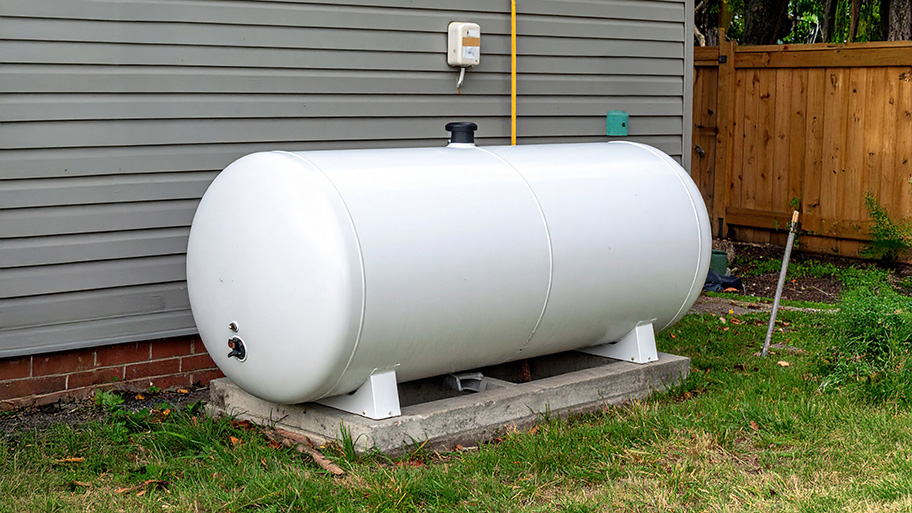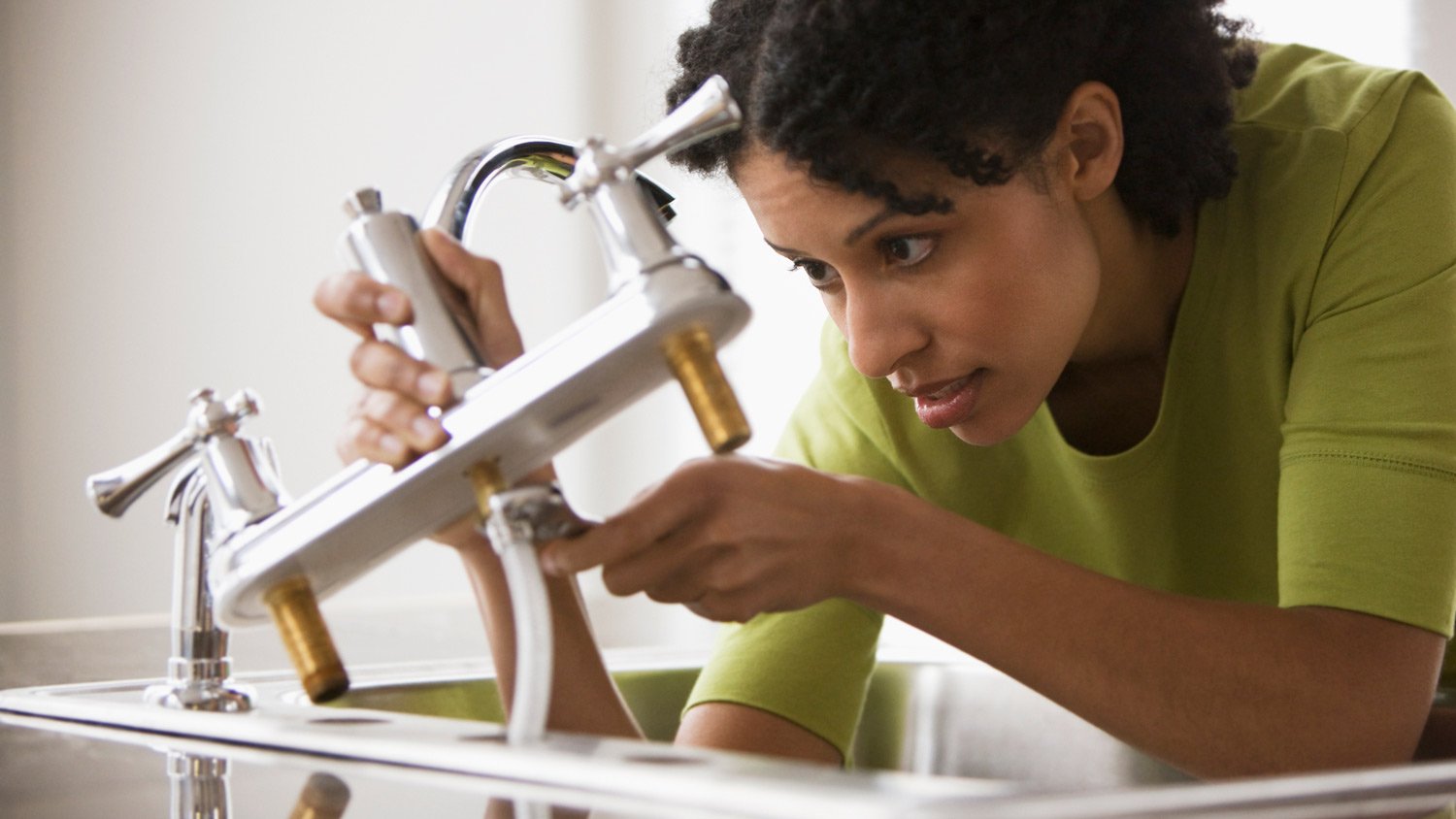
The average propane tank costs between $600 and $2,500, depending on the size, location, and more. Our expert guide explores all the factors.
Don’t let low water pressure inconvenience you


Low water pressure is a problem many homeowners can fix and it’s far less damaging than dealing with high water pressure.
Troubleshoot low water pressure by checking your aerator, water lines, and pipes.
Water heaters are the likely culprit for low pressure in hot water.
Normal water pressure ranges from 45 to 80 psi and is considered low when it drops below 40 psi.
Low water pressure can be frustrating, especially when it’s in a room you use as often as the kitchen. Although both high and low water pressure indicate problems, high water pressure is more damaging and can require hiring a local plumber.
Luckily, fixing low water pressure can be a DIY job. By investigating some parts of the sink, you can determine the source of low water pressure in the kitchen faucet and solve the issue.

Located at the end of the faucet spout, the aerator consists of a screen that covers the water outlet and controls the flow rate. In addition, it conserves water by adding air to the water stream. When minerals or hard water clog the aerator, the result is often low water pressure.
Twist the aerator clockwise, and if necessary, use pliers with tape to get a better grip.
Remove the metal or plastic screen inside and scrub with an old toothbrush.
If it’s super clogged, soak the aerator in vinegar overnight, brush off the remaining debris, and reattach it to the faucet.
The cartridge is responsible for opening the valves for water to flow and turning off the water when you shut off the tap. In addition, it contributes to preventing leaks and other malfunctions. From time to time, debris, hard water, sediment, and corrosion can build up in the cartridge, resulting in low water pressure.
Turn off the supply valves under the sink and turn on the faucet to release the residual water.
Use your sink stopper to ensure nothing gets into the drain.
Using a screwdriver, detach the cap covering the faucet screw.
With an Allen wrench, remove the screw cap.
Locate the retaining nut, which is at the base of the handle, and remove it with a wrench.
Pull out the cartridge and soak it in vinegar and warm water overnight.
Use a hard-bristled brush to scrub the cartridge.
If the cartridge is still scratched up, it’s time for a replacement.
Broken or damaged water lines result in water pressure problems. Common causes of water line damage include corrosion, debris, and sediment. When these occur, nearby faucets are affected.
Shut off the water under the sink.
Place a bucket under the sink—the bucket can catch potential residual water that may flow out after you disconnect the supply line.
Turn the nuts on the water supply line under the sink counterclockwise to loosen the line; if they don't turn, use a wrench to loosen them.
With the line pointed into the bucket, turn the water back on.
If water comes out, the culprit of the low water pressure is within your faucet—in this case, it’s time to replace the faucet.
If no water comes out, call a plumber who will be able to help you understand the issue.
When a pipe that supplies water leaks, the result may be low water pressure. You may have a leaking or burst pipe if you notice low water pressure during cold weather. If there is any excess water in areas under and around the kitchen sink, this could indicate a pipe leak.
Since leaks aren’t always visible, check the basement for watermarks near pipes, and inspect areas around water heaters and faucets. To check for hidden bathroom leaks, look for musty smells, mildew, damaged paint/wallpaper, ceiling stains, and damaged flooring. If you notice any of these signs, consider trying a temporary fix for leaking pipes, and contact a local plumber who can diagnose the problem and fix the leak.
The PRV is responsible for controlling the water pressure from the water that comes from the municipal supply. It has a bell shape and is located on the incoming water line.
Loosen the screw on the top of the valve.
Turn the screw counterclockwise and check the water pressure.
If the water pressure is still low, the valve might be ready for a replacement, and it’s time to call a plumber to find out.

The shut-off valve controls the water flow to your kitchen faucet and is located under the sink. Over time, these valves become damaged because of corrosion, mineral deposits, or normal wear and tear.
When the valve is partially closed or damaged, it can restrict the water flow and cause low water pressure.
Make sure the valve is fully open—it can accidentally get turned to a partially closed position.
Check for visible corrosion or damage.
If the valve doesn’t turn freely or is damaged (especially if you notice any leaking), it’s time to replace the valve.
If you don’t know how to replace the valve, it’s best to call a professional plumber to avoid water damage.
Pipe corrosion is a natural result of having metal pipes. It looks like rust or as if sections of your pipes have been slowly eaten away. There are several reasons you’d find corroded pipes around your home. These include a pH imbalance in your water, high water velocity, high levels of dissolved oxygen, and water and oxygen exposure over time.
The buildup of corrosion in your pipes could be the reason you’re dealing with low water pressure. You might also notice discolored water or water with a bad taste or smell. If you spot the signs of corrosion early enough, you could get away with performing a pipe descaling or cleaning of your pipes. If not, you’ll need to outsource the work to a plumbing professional for a pipe replacement.
Your water heater keeps you from using freezing cold water for daily tasks like cooking, cleaning, washing your hands, and showering. As the unit heats the water, calcium and magnesium minerals form and settle at the bottom of your tank. The buildup of these sediments can cause low water pressure.
Flush your unit.
Drain your unit and perform a vinegar soak.
Keep the unit at the recommended temperature.
Install a water softener.
When your water supply comes from your city, whatever happens to their system will eventually trickle into your home. If they’re dealing with low water pressure, so will you. All you can do is contact your local water supplier and wait for them to fix the problem.

If only your hot water has low pressure, the issue is likely your water heater. Check the water heater to ensure the outlet valve is completely open. Try loosening the valve and see if this solves things.
Another issue could be sediment buildup in the water heater. Flushing or draining your water heater around twice a year can help prevent this, and flushing it at the sign of low hot water pressure can also help.
If neither strategy helps the issue, contact a plumbing repair pro near you, who can identify and fix the problem.
If you notice low water pressure in the entire house, ask your neighbors if they’re facing this problem—if they are, this is an indication that your municipal water supply is the problem. Contact your water provider to report the issue and get more information.
Some low water pressure issues can be fixed with DIY solutions, but there are times when the best course of action is to call a professional plumber. If you’ve tried simple troubleshooting steps and still have low water pressure, it’s likely time to bring in an expert.
Other warning signs include noticing water damage on your walls or under your sink, your water bill suddenly increasing for no obvious reason, and unusual sounds coming from your water pipes.
A licensed plumber will save you money in the long run because they can accurately identify the reason your water pressure is low and safely fix the problem. If the problem is isolated to your kitchen faucet, you can call a faucet repair pro near you to take a look.
We needed a couple of minor plumbing repairs done. Lopez Plumbing arrived on time and was very respectful of our time and space and have reasonable advice about the maintenance of equipment and proactive steps to take.
Quality plumbing work!!! Very responsive and transparent about all costs up front. Overall I was very satisfied with his professionalism and quality of work!!!
Overall much higher quality work, now the walls are plumb and square, tile pattern is correct and well balanced. The bathroom design is exactly the same other than a few minor details where they suggested a different angle or joint but if you could see them side by side there's no comparison...
I have rental properties and every time I hired this company for any plumbing-related issue, they always solved the problem. I would not work with anyone else, I trust them completely. I have been using this company for years.
We purchased a home that was need of a bit of work and I had great difficulty finding good firms that charged fair prices and performed well. I first hired JMZ to clean the yard and cut the grass. I saw Jose's truck in the area and called the number on the side. In the past two years Jose and...
Andrew and his crew at Islander painting are precise and clean up after their work. I would definitely hire them again!!!
Armend Gojani at Rite Plumbing and Heating is incredibly nice, courteous, knowledgeable and honorable. He has been a pleasure to work with, and so far most of the plumbing problems have been fixed - one more to go.
Clayton and his associate were fantastic! He accommodated my request to remove a considerable amount of stuff from a residential home in Port Orange (even changing my original appointment date very last minute at my request). He was early to the job, careful not to remove or damage anything...
Professional, courteous and great quality. Would hire the team again.
Tell me that unless I pay $95 they will not come out to give me an estimate
From average costs to expert advice, get all the answers you need to get your job done.

The average propane tank costs between $600 and $2,500, depending on the size, location, and more. Our expert guide explores all the factors.

Whether you’re changing your home’s floor plan in a remodel or just replacing old, worn-out plumbing, this guide will help you estimate the cost of repiping a house.

The cost to replace cast iron pipes depends on many factors, like size and accessibility. Use this guide to get a rough idea of how much you’ll spend.

If you're concerned about the water quality at your home, it may be time to install a water purification system. Different types of water purification can offer different benefits for removing debris, particles, dirt, bacteria, and viruses from your water.

Most homeowners will eventually need to replace bathroom hardware. This guide breaks down bathtub faucet installation costs, so you can upgrade your bathroom.

An undermount sink can create a sleek, seamless aesthetic for your kitchen sink. Use this guide to learn how you can replace and install your undermount sink.